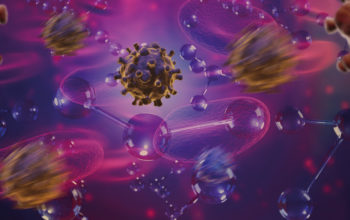
Date: 12th November 2021
Triple-negative breast cancer (TNBC) is an aggressive malignancy that accounts for about 15% of all breast cancers. These cancerous cells lack receptors commonly found in breast cancer and therefore, using targeted cancer therapies is not currently an option for treating TNBC. Furthermore, immune exclusion which is a feature of this and some other cancers predicts poor patient outcomes. Now, researchers identify a key molecule, DDR1, that prevents immune cells from entering TNBC tumours and destroying the cancerous cells, depletion of DDR1 halts tumour growth and protects against future tumours – opening new avenues for targeting aggressive breast cancer.
How tumours exclude immune infiltrates to avoid immune destruction is poorly understood but it thought to involve the extracellular matrix. Whilst strategies to overcome ECM abundance have been trialled, they are largely ineffective or cause undesired outcomes. One player, discoidin domain receptor 1 (DDR1), a collagen receptor with tyrosine kinase activity, shows increased expression which correlates with cancer progression, and promotes tumour progression and metastases - suggesting it may be a good molecule to target for TNBC treatment - however, to date these mechanisms remain elusive and therefore DDR1 has previously flown under the scientific radar.
Now, researchers at George Washington University, US, led by Rong Li, show that ablation of Ddr1 in tumours promoted the intratumoural penetration of T cells and obliterated tumour growth in mouse models of TNBC. Furthermore, in human TNBC DDR1 expression negatively correlated with an abundance of anti-tumour T cells within a tumour. Development of a therapeutic DDR1-targetting antibody disrupted collagen fibre alignment, mitigated immune exclusion and inhibited tumour growth.
To start, the team investigated the role of DDR1 in three mouse models of TNBC. Knockout (KO) of Ddr1 did not impair cell proliferation in vitro or tumour growth in immunodeficient hosts. However in contrast, Ddr1-KO tumours did not grow in immunocompetent hosts or if tumours were re-transplanted from immunodeficient to immunocompetent mice. Upon depletion of CD8+ cells in immunocompetent mice the KO tumours then grew as robustly as the control tumours. Transfer of CD8+ T cells into tumour-bearing immunodeficient mice generated more abundant tumour-infiltrating lymphocytes, and resulted in smaller tumours. Interestingly, when Ddr1-WT tumour cells were injected into immunocompetent mice that had previously been challenged with Ddr1-KO tumour cells, tumours did not grow over a 6 month period – suggesting that Ddr1-KO tumour cells can vaccinate hosts against Ddr1-WT tumours. Collectively, these results suggested that DDR1 deters host anti-tumour immunity.
To provide mechanistic insight the team performed functional rescues using different deletion and mutated Ddr1 constructs. They found that the DDR1 extracellular domain (DDR1-ECD) which binds to collagen, but not its kinase activity, was required for tumour growth in immunocompetent hosts. The binding to collagen enforced aligned collagen fibres and obstructed immune infiltration. Furthermore, ECD-neutralising antibodies were able to disrupt collagen fibre alignment thus mitigated immune exclusions and inhibited tumour growth in immunocompetent animals, making this a plausible strategy for fighting TNBC.
Conclusions and future applications
The team here have identified a new mechanism for immune exclusion for TNBC, DDR1 promoted collagen fibre alignment which prevented immune cells from tumour infiltration. Anti-DDR1 antibodies reduced tumour size, in some cases causing complete regression, and reduced the incidence of tumours after rechallenge.
It is hoped that the study will inform the development of new stand-alone therapeutic agents that target ECM remodelling, and the team predict that anti-DDR1 antibodies could serve as an alternative anti-cancer immunotherapy for several different types of cancer. With this deeper understanding of the role for DDR1 in cancer, the researchers will be looking to seek additional molecules akin to DDR1 to fight other cancers.
The work should add to the recent progress that researchers are developing to treat aggressive cancer. New genes have been identified that cause aggressive breast cancer to rapidly grown and metastasise, inhibition of the gene, TRAF3IP2, repressed tumour formation, reduced preformed tumours, and prevented metastasis. New classes of drug targets are also being explored such as RNA-binding proteins, one of which - YTHDF2 - when inhibited triggered apoptosis in triple-negative breast cancer cells and tumours. The advances are not just aimed at treating breast cancer, other aggressive cancers such as glioblastoma are also seeing new tools being developed such as synthetic nanoparticles and immunocytokines. Together, these innovative applications are starting to offer alternative treatments for hard-to-treat cancers, and offer to provide better outcomes for patients.
For more information please see the press release at George Washington University
Sun, X., Wu, B., Chiang, H.-C., Deng, H., Zhang, X., Xiong, W., Liu, J., Rozeboom, A.M., Harris, B.T., Blommaert, E., et al. (2021). Tumour DDR1 promotes collagen fibre alignment to instigate immune exclusion. Nature.
https://doi.org/10.1038/s41586-021-04057-2

